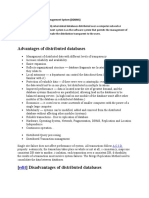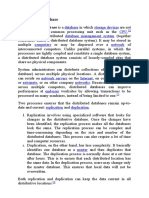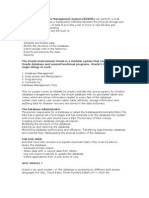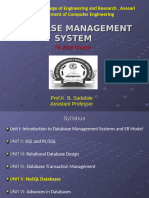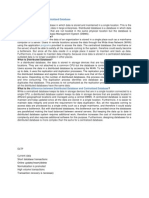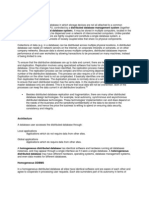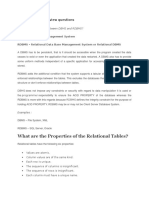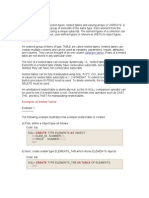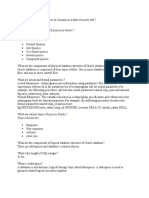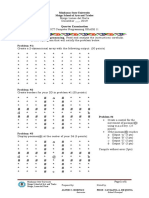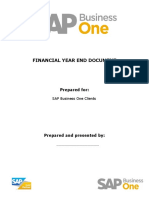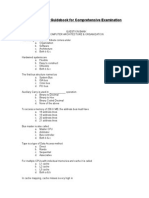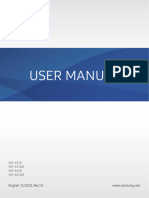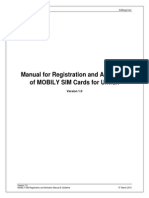An Introduction To Distributed Databases Replicating Data
An Introduction To Distributed Databases Replicating Data
Uploaded by
Subhamoy RoyCopyright:
Available Formats
An Introduction To Distributed Databases Replicating Data
An Introduction To Distributed Databases Replicating Data
Uploaded by
Subhamoy RoyOriginal Title
Copyright
Available Formats
Share this document
Did you find this document useful?
Is this content inappropriate?
Copyright:
Available Formats
An Introduction To Distributed Databases Replicating Data
An Introduction To Distributed Databases Replicating Data
Uploaded by
Subhamoy RoyCopyright:
Available Formats
Distributed Databases
An Introduction to Distributed Databases Replicating Data
Good sense is of all things in the world the most equally distributed, for everybody thinks he is so well supplied with it, that even the most difficult to please in all other matters never desire more of it than they already possess. Rene Descartes: Le Discours de la Methode This chapter describes what a distributed database is, the benefits of distributed database systems, and the Oracle distributed database architecture. The chapter includes:
An Introduction to Distributed Databases Replicating Data
Note: The information in this chapter applies only for those systems using Oracle with the distributed or advanced replication options. See Oracle7 Server Distributed Systems, Volume I and Oracle7 Server Distributed Systems, Volume II for more information about distributed database systems and replicated environments. If you are using Trusted Oracle, see the Trusted Oracle7 Server Administrator's Guide for information about distributed databases in that environment. An Introduction to Distributed Databases A distributed database appears to a user as a single database but is, in fact, a set of databases stored on multiple computers. The data on several computers can be simultaneously accessed and modified using a network. Each database server in the distributed database is controlled by its local DBMS, and each cooperates to maintain the consistency of the global database. Figure 21 - 1 illustrates a representative distributed database system. The following sections outline some of the general terminology and concepts used to discuss distributed database systems. Clients, Servers, and Nodes A database server is the software managing a database, and a client is an application that requests information from a server. Each computer in a system is a node. A node in a distributed database system can be a client, a server, or both. For example, in Figure 21 - 1, the computer that manages the HQ database is acting as a database server when a statement is issued against its own data (for example, the second statement in each transaction issues a query against the local DEPT table), and is acting as a client when it issues a statement against remote data (for example, the first statement in each transaction is issued against the remote table EMP in the SALES database). Oracle supports heterogeneous client/server environments where clients and servers use different character sets. The character set used by a client is defined by the value of the NLS_LANG parameter for the client session. The character set used by a server is its database character set. Data conversion is done automatically between these
character sets if they are different. For more information about National Language Support features, refer to Oracle7 Server Reference. Direct and Indirect Connections A client can connect directly or indirectly to a database server. In Figure 21 - 1, when the client application issues the first and third statements for each transaction, the client is connected directly to the intermediate HQ database and indirectly to the SALES database that contains the remote data.
Figure 21 - 1. An Example of a Distributed DBMS Architecture Site Autonomy Site autonomy means that each server participating in a distributed database is administered independently (for security and backup operations) from the other databases, as though each database was a non-distributed database. Although all the databases can work together, they are distinct, separate repositories of data and are administered individually. Some of the benefits of site autonomy are as follows:
Nodes of the system can mirror the logical organization of companies or cooperating organizations that need to maintain an "arms length" relationship. Local data is controlled by the local database administrator. Therefore, each database administrator's domain of responsibility is smaller and more manageable. Independent failures are less likely to disrupt other nodes of the distributed database. The global database is partially available as long as one database and the network are available; no single database failure need halt all global operations or be a performance bottleneck. Failure recovery is usually performed on an individual node basis. A data dictionary exists for each local database. Nodes can upgrade software independently.
Schema Objects and Naming in a Distributed Database A schema object (for example, a table) is accessible from all nodes that form a distributed database. Therefore, just as a non-distributed local DBMS architecture must provide an unambiguous naming scheme to distinctly reference objects within the local database, a distributed DBMS must use a naming scheme that ensures that objects throughout the distributed database can be uniquely identified and referenced. To resolve references to objects (a process called name resolution) within a single database, the DBMS usually forms object names using a hierarchical approach. For example, within a single database, a DBMS guarantees that each schema has a unique name, and that within a schema, each object has a unique name. Because uniqueness is enforced at each level of the hierarchical structure, an object's local name is guaranteed to be unique within the database and references to the object's local name can be easily resolved. Distributed database management systems simply extend the hierarchical naming model by enforcing unique database names within a network. As a result, an object's global object name is guaranteed to be unique within the distributed database, and references to the object's global object name can be resolved among the nodes of the system. For example, Figure 21 - 2 illustrates a representative hierarchical arrangement of databases throughout a network and how a global database name is formed.
Figure 21 - 2. Network Directories and Global Database Names Database Links To facilitate connections between the individual databases of a distributed database, Oracle uses database links. A database link defines a "path" to a remote database. Database links are essentially transparent to users of a distributed database, because the name of a database link is the same as the global name of the database to which the link points. For example, the following statement creates a database link in the local database. The database link named SALES.DIVISION3.ACME.COM describes a path to a remote database of the same name. CREATE PUBLIC DATABASE LINK sales.division3.acme.com ... ; At this point, any application or user connected to the local database can access data in the SALES database by using global object names when referencing objects in the SALES database; the SALES database link is implicitly used to facilitate the connection to the SALES database. For example, consider the following remote query that references the remote table SCOTT.EMP in the SALES database: SELECT * FROM scott.emp@sales.division3.acme.com; Statements and Transactions in a Distributed Database
The following sections introduce the terminology used when discussing statements and transactions in a distributed database environment. Remote and Distributed Statements A remote query is a query that selects information from one or more remote tables, all of which reside at the same remote node. A remote update is an update that modifies data in one or more tables, all of which are located at the same remote node. Note: A remote update may include a subquery that retrieves data from one or more remote nodes, but because the update is performed at only a single remote node, the statement is classified as a remote update. A distributed query retrieves information from two or more nodes. A distributed update modifies data on two or more nodes. A distributed update is possible using a program unit, such as a procedure or trigger, that includes two or more remote updates that access data on different nodes. Statements in the program unit are sent to the remote nodes, and the execution of the program succeeds or fails as a unit. Remote and Distributed Transactions A remote transaction is a transaction that contains one or more remote statements, all of which reference the same remote node. A distributed transaction is any transaction that includes one or more statements that, individually or as a group, update data on two or more distinct nodes of a distributed database. If all statements of a transaction reference only a single remote node, the transaction is remote, not distributed. Two-Phase Commit Mechanism A DBMS must guarantee that all statements in a transaction, distributed or nondistributed, are either committed or rolled back as a unit, so that if the transaction is designed properly, the data in the logical database can be kept consistent. The effects of a transaction should be either visible or invisible to all other transactions at all nodes; this should be true for transactions that include any type of operation, including queries, updates, or remote procedure calls. The general mechanisms of transaction control in a non-distributed database are discussed in Chapter 12, "Transaction Management". In a distributed database, Oracle must coordinate transaction control over a network and maintain data consistency, even if a network or system failure occurs. A two-phase commit mechanism guarantees that all database servers participating in a distributed transaction either all commit or all roll back the statements in the transaction. A two-phase commit mechanism also protects implicit DML operations performed by integrity constraints, remote procedure calls, and triggers. Two-phase commit is described in Chapter 1, "Introduction to the Oracle Server". Transparency in a Distributed Database System The functionality of a distributed database system must be provided in such a manner that the complexities of the distributed database are transparent to both the database users and the database administrators.
For example, a distributed database system should provide methods to hide the physical location of objects throughout the system from applications and users. Location transparency exists if a user can refer to the same table the same way, regardless of the node to which the user connects. Location transparency is beneficial for the following reasons:
Access to remote data is simplified, because the database users do not need to know the location of objects. Objects can be moved with no impact on end-users or database applications.
A distributed database system should also provide query, update, and transaction transparency. For example, standard SQL commands, such as SELECT, INSERT, UPDATE, and DELETE, should allow users to access remote data without the requirement for any programming. Transaction transparency occurs when the DBMS provides the functionality described below using standard SQL COMMIT, SAVEPOINT, and ROLLBACK commands, without requiring complex programming or other special operations to provide distributed transaction control.
The statements in a single transaction can reference any number of local or remote tables. The DBMS guarantees that all nodes involved in a distributed transaction take the same action: they either all commit or all roll back the transaction. If a network or system failure occurs during the commit of a distributed transaction, the transaction is automatically and transparently resolved globally; that is, when the network or system is restored, the nodes either all commit or all roll back the transaction.
A distributed DBMS architecture should also provide facilities to transparently replicate data among the nodes of the system. Maintaining copies of a table across the databases in a distributed database is often desired so that
Tables that have high query and low update activity can be accessed faster by local user sessions because no network communication is necessary. If a database that contains a critical table experiences a prolonged failure, replicates of the table in other databases can still be accessed.
A DBMS that manages a distributed database should make table replication transparent to users working with the replicated tables. Finally, the functional transparencies explained above are not sufficient alone. The distributed database must also perform with acceptable speed. SQL*Net and Network Independence When data is required from remote databases, a local database server communicates with the remote database using the network, network communications software, and
Oracle's SQL*Net. Just as SQL*Net connects clients and servers that operate on different computers of a network, it also connects database servers across networks to facilitate distributed transactions. For more information about SQL*Net and its features, see "SQL*Net" . Heterogeneous Distributed Database Systems The Oracle distributed database architecture allows the mix of different versions of Oracle along with database products from other companies to create a heterogeneous distributed database system. The Mechanics of a Heterogeneous Distributed Database In a distributed database, any application directly connected to an Oracle database can issue a SQL statement that accesses remote data in the following ways:
Data in another Oracle database is available, no matter what version. All Oracle databases are connected by a network and use SQL*Net to maintain communication. Data in a non-Oracle database (such as an IBM DB2 database) is available, assuming that the non-Oracle database is supported by Oracle's gateway architecture, SQL*Connect. You can connect the Oracle and non-Oracle databases with a network and use SQL*Net to maintain communication. See the appropriate SQL*Connect documentation for more information about this product.
Figure 21 - 3 illustrates a heterogeneous distributed database system encompassing different versions of Oracle and non-Oracle databases.
Figure 21 - 3. Heterogeneous Distributed Database Systems When connections from an Oracle node to a remote node (Oracle or non-Oracle) initially are established, the connecting Oracle node records the capabilities of each remote system and the associated gateways. SQL statement execution proceeds, as described in the section "Statements and Transactions in a Distributed Database" . However, in heterogeneous distributed systems, SQL statements issued from an Oracle database to a non-Oracle remote database server are limited by the capabilities of the remote database server and associated gateway. For example, if a remote or distributed query includes an Oracle extended SQL function (for example, an outer join), the function may have to be performed by the local Oracle database. Extended SQL functions in remote updates (for example, an outer join in a subquery) are not supported by all gateways; see your specific SQL*Connect documentation for more information on the capabilities of your system.
You might also like
- Distributed DatabaseDocument7 pagesDistributed Databaseaathi sivakumarNo ratings yet
- Adt Unitnotes 1to3Document107 pagesAdt Unitnotes 1to3John Solomon GameNo ratings yet
- Adt Unit IDocument18 pagesAdt Unit ISavithri SubramanianNo ratings yet
- Unit 1Document12 pagesUnit 1arjabkhadka93No ratings yet
- Advance Concept in Data Bases Unit-3 by Arun Pratap SinghDocument81 pagesAdvance Concept in Data Bases Unit-3 by Arun Pratap SinghArunPratapSingh100% (2)
- First Normal FormDocument28 pagesFirst Normal FormAkansha RawatNo ratings yet
- Distributed Database Management SystemDocument5 pagesDistributed Database Management SystemGeeti JunejaNo ratings yet
- Distributed Databases IntroductionDocument16 pagesDistributed Databases IntroductionTirth Nisar100% (1)
- Rdbms Question Bank Unit Test 1Document5 pagesRdbms Question Bank Unit Test 1Sahil ImßacArn KaleKarNo ratings yet
- DDS Unit - 1-1Document22 pagesDDS Unit - 1-1Gamer BhagvanNo ratings yet
- Distributed Database Transparency FeaturesDocument6 pagesDistributed Database Transparency FeaturesH YasirNo ratings yet
- Unit 5Document23 pagesUnit 5Dead ManNo ratings yet
- Part 2Document8 pagesPart 2Mariane CalospoNo ratings yet
- 115 SQL Interview Questions and AnswersDocument34 pages115 SQL Interview Questions and AnswersChristine CaoNo ratings yet
- Distributed DBMSDocument7 pagesDistributed DBMSbmintegNo ratings yet
- Distributed Database: Database Storage Devices CPU Database Management System Computers NetworkDocument9 pagesDistributed Database: Database Storage Devices CPU Database Management System Computers NetworkSankari SoniNo ratings yet
- DBMS Updated Note - 1581657063Document40 pagesDBMS Updated Note - 1581657063ArpoxonNo ratings yet
- CHAPTER 2 DbmsDocument5 pagesCHAPTER 2 DbmsabcNo ratings yet
- System Admin and Server IntegrationDocument3 pagesSystem Admin and Server Integrationmanoj22490No ratings yet
- Database MC ADocument16 pagesDatabase MC AMaheswari MNo ratings yet
- Sakshi dbms2Document55 pagesSakshi dbms2Priyanshu PareekNo ratings yet
- What Is A Distributed DatabaseDocument8 pagesWhat Is A Distributed Databasegaurav621.961No ratings yet
- DIBAS - A Management System For Distributed Databases: by Eirik Dahle and Helge BergDocument11 pagesDIBAS - A Management System For Distributed Databases: by Eirik Dahle and Helge BergMrinal MondalNo ratings yet
- DDBMS ArchitectureDocument11 pagesDDBMS ArchitectureArnab SahaNo ratings yet
- Q # 1: What Are The Components of Distributed Database System? Explain With The Help of A Diagram. AnswerDocument12 pagesQ # 1: What Are The Components of Distributed Database System? Explain With The Help of A Diagram. AnswerAqab ButtNo ratings yet
- Summative Assesment 2Document3 pagesSummative Assesment 2shite.molefeNo ratings yet
- TheoeyDocument114 pagesTheoeysonabeta07No ratings yet
- Operating System: COPE/Technical Test/Interview/Database Questions & AnswersDocument25 pagesOperating System: COPE/Technical Test/Interview/Database Questions & AnswersVasu DevanNo ratings yet
- Introduction To OracleDocument8 pagesIntroduction To Oracleapi-3805308No ratings yet
- Data Handling in I.O.T: R.K.BiradarDocument17 pagesData Handling in I.O.T: R.K.BiradarRavi BiradarNo ratings yet
- Distributed DBDocument16 pagesDistributed DBArchana SaravananNo ratings yet
- Distributed Database Systems: January 2002Document25 pagesDistributed Database Systems: January 2002Mubashra RehmaniNo ratings yet
- Assignment # 2: Submitted by Submitted To Class Semester Roll NoDocument9 pagesAssignment # 2: Submitted by Submitted To Class Semester Roll NoNABEEL BHATTINo ratings yet
- ADT NotesDocument36 pagesADT Notesbravejaya2002No ratings yet
- SQL TutorialDocument207 pagesSQL TutorialMd FasiuddinNo ratings yet
- Distributed Databases: Rohini College of Engineering & TechnologyDocument5 pagesDistributed Databases: Rohini College of Engineering & TechnologymentalinsideNo ratings yet
- Github Com Aman0046 LastMinuteRevision DBMSDocument8 pagesGithub Com Aman0046 LastMinuteRevision DBMSGEN GENTLE INFAMOUSNo ratings yet
- Unit - 1 - Part3 - DBMS ArchitectureDocument4 pagesUnit - 1 - Part3 - DBMS ArchitectureAnmol MogalaiNo ratings yet
- Exploring The Capabilities of DB2 Universal DatabaseDocument5 pagesExploring The Capabilities of DB2 Universal DatabaseAbdul Kadir ArsiwalaNo ratings yet
- Unit V NoSQL DatabasesDocument124 pagesUnit V NoSQL DatabasesSupriya SalkeNo ratings yet
- DbmsDocument95 pagesDbmstanmayi nandirajuNo ratings yet
- Database - Advantages & DisadvantagesDocument5 pagesDatabase - Advantages & DisadvantagesDipak JadhavNo ratings yet
- A Primer On Database Clustering Architectures: by Mike Hogan, Ceo Scaledb IncDocument7 pagesA Primer On Database Clustering Architectures: by Mike Hogan, Ceo Scaledb IncShukur SharifNo ratings yet
- Unit 5Document28 pagesUnit 5ramshankarchauhan37No ratings yet
- DISTRIBUTED DATABASES PresentationDocument13 pagesDISTRIBUTED DATABASES PresentationkmapukeNo ratings yet
- Distributed Databases: Presentation-IDocument30 pagesDistributed Databases: Presentation-Irohit_vishwakarma786No ratings yet
- What Is Centralized Database?Document8 pagesWhat Is Centralized Database?Kanchan MujumdarNo ratings yet
- DBMS NotesDocument6 pagesDBMS Notesyashg7184No ratings yet
- Distributed Database Vs Conventional DatabaseDocument4 pagesDistributed Database Vs Conventional Databasecptsankar50% (2)
- What Is RDBMS (Relational Database Management System) ?Document54 pagesWhat Is RDBMS (Relational Database Management System) ?sreenivaasreddy4197No ratings yet
- Unit 4-DBPDocument66 pagesUnit 4-DBPpriyadharshinimr50No ratings yet
- "Coding, A Rhythmic Literary Job": Relational Database Management SystemDocument33 pages"Coding, A Rhythmic Literary Job": Relational Database Management SystemRajesh PedamuttiNo ratings yet
- Distributed DatabasesDocument46 pagesDistributed DatabasesSoumya VijoyNo ratings yet
- Module 1Document24 pagesModule 1RAMYA KANAGARAJ AutoNo ratings yet
- DBMSDocument29 pagesDBMSapi-3760815100% (1)
- What Are The Properties of The Relational Tables?: SQL Server Full Interview QuestionsDocument27 pagesWhat Are The Properties of The Relational Tables?: SQL Server Full Interview QuestionsAnuj PatelNo ratings yet
- Assignment 1st DDBDocument9 pagesAssignment 1st DDBanguralrakesh80No ratings yet
- Distributed Database SystemDocument15 pagesDistributed Database Systemwater khanNo ratings yet
- De NormalizationDocument16 pagesDe NormalizationSubhamoy RoyNo ratings yet
- CollectionsDocument60 pagesCollectionsSubhamoy RoyNo ratings yet
- Oracle Forms QuesDocument13 pagesOracle Forms QuesSubhamoy RoyNo ratings yet
- Oracle Forms QuesDocument13 pagesOracle Forms QuesSubhamoy RoyNo ratings yet
- Faq'sDocument159 pagesFaq'ssagar1234567No ratings yet
- Quarter Examination: Mindanao State University Maigo School of Arts and TradesDocument1 pageQuarter Examination: Mindanao State University Maigo School of Arts and TradesJaver BorngoNo ratings yet
- All Digital Hub PricelistDocument3 pagesAll Digital Hub PricelistOdlanorSontsa100% (1)
- M22T AVEVA Plant - 12 Series - Создание каталогов элементов трубопроводов - Rev 0.6 -Document161 pagesM22T AVEVA Plant - 12 Series - Создание каталогов элементов трубопроводов - Rev 0.6 -Ionut Catoiu100% (1)
- ES Lab Manual DSP Board-EmbeddedDocument77 pagesES Lab Manual DSP Board-EmbeddedemillianoNo ratings yet
- Version 1Document8 pagesVersion 1Dr Mehar Aamir HomoeopathNo ratings yet
- Information Security PolicyDocument33 pagesInformation Security PolicyElbert100% (3)
- SAP Business One Finanacial Year End DocumentDocument17 pagesSAP Business One Finanacial Year End DocumentHillary Kirui100% (1)
- Resume AdityaSarinDocument3 pagesResume AdityaSarinTushar Kant Verma0% (1)
- CA&ODocument12 pagesCA&OMohammad AhmedNo ratings yet
- VAPT7.E37780 - Solenoids For Use in Hazardous Locations Certified For Canada - UL Product IqDocument2 pagesVAPT7.E37780 - Solenoids For Use in Hazardous Locations Certified For Canada - UL Product IqFakhreddine EzzahiNo ratings yet
- Running LogDocument5 pagesRunning Loghadidhabibi90No ratings yet
- Manual Rev.1.0 231204Document174 pagesManual Rev.1.0 231204Willy K. Ng'etichNo ratings yet
- SIM Registration and Activation - MOBILY v10 - DOWNLOAD.6470623Document12 pagesSIM Registration and Activation - MOBILY v10 - DOWNLOAD.6470623shamraiz_dar100% (1)
- 75rt Ad Ccpulse+Document94 pages75rt Ad Ccpulse+RoyalDSouzaNo ratings yet
- Java - All in One (FAQs)Document138 pagesJava - All in One (FAQs)api-3728136No ratings yet
- Assignment No 1: Write X86 ALP To Count, Positive and Negative Numbers From The ArrayDocument142 pagesAssignment No 1: Write X86 ALP To Count, Positive and Negative Numbers From The ArrayAvinash Wankhede PatilNo ratings yet
- ExcelDocument17 pagesExcelAlthimese AndersonNo ratings yet
- Massive Information Retrieval of Personalized Historical Timeline From The WebDocument27 pagesMassive Information Retrieval of Personalized Historical Timeline From The WebOrkhan HuseynliNo ratings yet
- Information Technology For Managers: Enterprise SystemsDocument39 pagesInformation Technology For Managers: Enterprise SystemsFitri ArdaniNo ratings yet
- IPv 6Document31 pagesIPv 6Bijay LamaNo ratings yet
- SQL QuizDocument138 pagesSQL QuizPravin PoudelNo ratings yet
- Teltronic MDT400Document2 pagesTeltronic MDT400mollarriNo ratings yet
- Electronic Money: Luis Enrique Heredia FigueroaDocument21 pagesElectronic Money: Luis Enrique Heredia FigueroaAmit VashisthNo ratings yet
- The Good Guide To Interactive WhiteboardsDocument8 pagesThe Good Guide To Interactive WhiteboardsVic LenchanteurNo ratings yet
- CSEC IT Mail Merge SBA ExampleDocument56 pagesCSEC IT Mail Merge SBA Examplexavier.da.gilesNo ratings yet
- Taxi PowerpointDocument20 pagesTaxi Powerpointmyintzumaung97No ratings yet
- Permissions Problems - DeniedDocument5 pagesPermissions Problems - DeniedGeo KalNo ratings yet
- cấu hình switch AlcatelDocument8 pagescấu hình switch Alcatelhiếu lý trần huỳnh50% (2)
- Guide For Setting Up A Dns Server in Red Hat / Centos / FedoraDocument14 pagesGuide For Setting Up A Dns Server in Red Hat / Centos / Fedoraanb100% (1)
- Control ReportDocument16 pagesControl ReportaftabNo ratings yet






